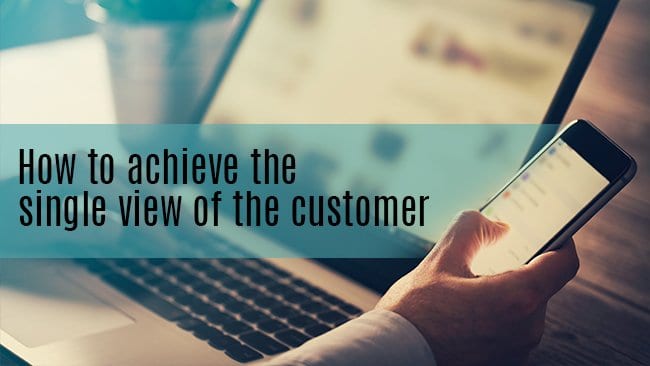
There are a number of steps that can be taken by organizations seeking to obtain a holistic view of their customers. It may prove to be a long process, but it will be worth it in the end.
What is single customer view?
In our last blog, we looked at how tough it is to deliver a complete customer experience if your organization does not have a single view of your consumers, as well as the difficulties faced by organizations as they seek to achieve a single view of their customers.
The good news is that despite the many difficulties that exist, there are ways to go about obtaining such a single view, which should ultimately lead to the creation of a unified, personalized customer experience, one that will increase customer loyalty and improve positive perceptions of your brand.
The first step is to ensure that you integrate the interaction history from your contact center with your customer relationship management (CRM) platform, as this will allow you to link your various customer identifiers together.
MultiChannel Customer Service:
This will mean that all customer interaction channels, such as the email addresses, phone numbers, Twitter and social media accounts of each individual user are properly linked together in the system. This, in turn, makes it easier to create and constantly update was is effectively a master record for each customer, which can be maintained within the CRM solution.
Since the number of channel-hopping customers is increasing all the time, it is also important to ensure that your agents are equipped with the right tools to manage this. Modern ICT solutions allow agents to manage these customers across multiple channels, from a single desktop, which not only makes them more efficient but ultimately ensures that they deliver more effective customer service. Also, you should make sure that you build contextual intelligence into the various digital channels, as when customers hop channels, you don’t want the context of their earlier interactions to be erased. Instead, you want to ensure a seamless transition from one channel to another, while keeping your agent in the loop at all times.
Allow your agents to customize their desktops so that these can be set to their own exact requirements and specific needs. This will mean that if the customer view changes to reflect something new, such as a sales campaign, for example, the agent is able to fine tune their desktop to suit these changes. Ideally, you want a simple drag and drop, fully configurable ‘no coding’ model, so that IT does not have to be involved in such customizations constantly.
You also need to ensure complete visibility of all your customers’ most recent interactions, across all channels. This is about more than consolidating information from your various front and back-end systems – it is about having access to recent emails, social media posts or even live chats by the customer, and grouping these together intelligently, so that agents are able to access them quickly, in order to provide optimal service to the customer at the right time.
Another thing that can improve your view of the customer is to integrate your telephony system with the CRM platform. Ensuring seamless integration between voice communications and the rest of your CRM system means that key information does not end up going unreported and untracked. If you operate from a number of sites and wish to maintain a single telephony and CRM system, you should consider moving to the cloud, as this encourages the adoption of a single standard for technology, as opposed to the usual disparate systems which are more difficult to integrate.
Furthermore, make sure that your contact center is future-proofed. It’s all good and well to have a center that supports all current interaction channels, but you also need to ensure that it is flexible enough to be able to accommodate new channels, possibly even ones that have not currently been thought of. After all, the rise of Instagram and Twitter in a very short space of time are good indications of just how quickly new channels may arise. And if your customers want to exploit them, you’d better be sure your contact center can add them as well.
Improving Customer Satisfaction:
Customer surveys and operational data provide good opportunities to learn more about your customers but don’t be shy to gather input from colleagues as well. Listening to what agents have to say about customers – they are, after all, the ones talking to them on a daily basis – should provide you with additional actionable insight. Combining this with information acquired from surveys and other operational data should help you to improve your overall view of the customer.
When putting together a single view of your customer, remember to be clear about what you want to achieve in doing so. It may be you are doing it to differentiate your brand, or perhaps you are trying to build long-term loyalty by improving customer satisfaction. Whatever your goal, having clarity about what this is will mean that creating a single view will add the value expected, while at the same time helping you to avoid unnecessary IT spend.
Of course, even if you can avoid unnecessary expenditure, some budget will definitely be required to achieve your goal. To this end, you will need to get board-level buy-in for your plans. After all, you will need to undertake numerous changes in both processes and technologies if you are to improve your customer service, and getting the investment required to make this happen at the outset will require the approval of the board. It may help to highlight the growing body of evidence that indicates that the more you understand the customers’ needs and translate this knowledge into effective service, the better your overall business results become.
An effective single view of the customer will enable you to know what your customers have done and why they have done it. It will not only allow you to understand what they are doing now but also what they are most likely to do in the future. If you know this, you can positively influence these elements to the benefit of both the customer and your business. As you gather increasing amounts of data about each customer, each time they interact with you, it is important to utilize this information effectively, gathering it simply because it is there is a waste of time; you must actually exploit it if you aim to benefit both your customers and your enterprise.
Once you have followed the above steps, you should be in a position where obtaining a single customer view is finally achievable. Doing this will not only benefit your contact center but the entire business, as marketing, sales and the like will all be in a better position to analyze prior customer behavior, in order to learn how best to target and personalize future customer interactions.
Achieving the single view of the customer will ultimately enable you to deliver a seamless and consistent customer experience, one polished with improved operational efficiency and greater agent responsiveness. It will also offer increased opportunities for cross- or up-selling, not to mention leading to more relevant marketing and better product development.
[About the author]


